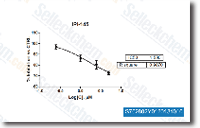Cells had been harvested, washed 3 times with PBS, then counted and resuspended in PBS at concentration of 1?106 cells ml. Of each sample 3?105 cells had been stained with two ug ml DAPI in methanol for 15 min at area temperature inside the dark. Subsequently, cells had been centrifuged at 1250 rpm for five min, resuspended in ice cold FACS buffer Austria and straight away analyzed through a FACSCanto II Flow Cytometer outfitted which has a BD FACSDiva acquisition and analysis plan Samples, stained with DAPI, had been thrilled which has a 405 nm blue laser and the emitted light in the region of 450 nm was recorded. Data from not less than ten,000 cell counts have been collected for each information file. Gating was set adequately to exclude cell debris, cell doublets, and cell clumps.
Apoptosis test The apoptosis response of HepG2 cells to CurcuEmul somes and free curcumin in DMSO were analyzed by Cell Meter selleck chemicals Caspase three 7 Exercise Apoptosis Red Fluores cence Assay Kit Briefly, HepG2 cells had been seeded in 96 nicely microtiter plates at a density of ten,000 cells per very well inside a ultimate volume of 100 uL culture medium. Following 24 h, the cell culture media had been as pirated as well as cells were taken care of by using a medium contain ing absolutely free curcumin or CurcuEmulsomes at several concentrations for 6, 24 and 48 h. Other cells have been left untreated as negative management. With the time of evaluation, the medium was replaced and equal volume of Z DEVD ProRed Reagent Assay was extra to each well. Following incubation of cells at space temperature for 70 min within the dark, the fluorescence intensity at Ex Em 535 635 nm was monitored by Infinite F200 plate reader. Ultraviolet noticeable absorbance spectroscopy UV vis absorbance spectroscopy was performed on the U 2900 UV Vis spectrophotometer Samples had been scanned from 300 to 700 nm.
Fluorescence spectroscopy Fluorescence spectra had been obtained on the Perkin Elmer LS fifty five luminescence spectrometer Aurora C inhibitor Curcumin samples were enthusiastic at 420 nm, and emission was monitored from 430 to 600 nm Dynamic and phase evaluation light scattering Diluted in one mM KCl solution CurcuEmul somes which has a last DPPC concentration of four ug ml were analyzed from the Zetasizer Nano ZS for his or her particle dimension distribution and zeta likely characteristics as previously de scribed Electron microscopy The shape as well as the integrity of CurcuEmulsomes had been analyzed by a FEI Tecnai G2 20 Transmission Electron Microscope at 120 kV outfitted with FEI Eagle 4  k camera following adverse staining with uranyl acetate as described by Ucisik et al. Fluorescence microscopy Nikon Eclipse TE2000 S fluorescence microscope was used to visualize the samples.
k camera following adverse staining with uranyl acetate as described by Ucisik et al. Fluorescence microscopy Nikon Eclipse TE2000 S fluorescence microscope was used to visualize the samples.
Hiv Protease Signal
Each virion comprises a viral envelope and associated matrix enclosing a capsid.
